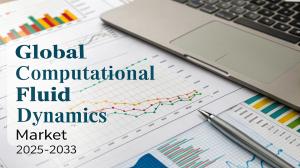Global Computational Fluid Dynamics Market Report 2025: Size Projected USD 5,081.3 Million, CAGR of 6.72% by 2033
Global CFD market to reach USD 5,081.3 million by 2033, driven by 6.72% CAGR amid rising demand in aerospace, automotive, and energy sectors.
NEW YORK, NY, UNITED STATES, June 25, 2025 /EINPresswire.com/ -- According to the latest report by IMARC Group, titled “Computational Fluid Dynamics Market Report by Deployment Model (Cloud-Based Model, On-Premises Model), End-User (Automotive, Aerospace and Defense, Electrical and Electronics, Industrial Machinery, Energy, Material and Chemical Processing, and Others), and Region 2025-2033”, offers a comprehensive analysis of the industry, which comprises insights on the global computational fluid dynamics (CFD) market. The report also includes competitor and regional analysis, and contemporary advancements in the global market.The global computational fluid dynamics (CFD) market size reached USD 2,652.2 million in 2024. Looking forward, IMARC Group expects the market to reach USD 5,081.3 million by 2033, exhibiting a growth rate (CAGR) of 6.72% during 2025-2033.
Request Free Sample Report: https://www.imarcgroup.com/computational-fluid-dynamics-market/requestsample
Global Computational Fluid Dynamics Market Dynamics:
Growing Demand for Virtual Prototyping and Design Optimization:
The worldwide market for Computational Fluid Dynamics (CFD) is primarily bolstered by the growing need for design optimisation and virtual prototyping in different sectors. Companies are increasingly using CFD simulations to evaluate fluid mechanics alongside heat transfer phenomena, especially in designing workflows and systems due to rising product intricacies and shrinking timelines. This capability enables designers to perform comprehensive virtual testing, refinement, and performance optimization on numerous What-If scenarios without incurring heavy costs associated with physical prototypes.
The automotive industry employs CFD for aerodynamics, engine cooling as well as battery thermal management; aerospace uses it for aircraft design, propulsion systems and cabin ventilation; manufacturing utilizes it in process and material optimization. These industries optimize their iterations and enhance compliance with regulations while maintaining efficiency focused Innovation cycles driven convergence of competition demanding accelerated cycles innovation agility responsiveness swift market directions At present there is no alternative owing speed depth enrich insights fluid behavior pace innovation significance hybrid integrate automated engineering workflows.
Advancements in High-Performance Computing (HPC) and Cloud-Based Solutions:
Another key factor influencing the worldwide Computational Fluid Dynamics (CFD) market is the enactment and heightened adoption of High-Performance Computing (HPC), alongside its powerful multi-core processors, graphic processing units (GPUs), and parallel computing frameworks. The simulating of fluid dynamics is CFD simulations which is compute-intensive in nature as Digital simulations also require tremendous computational resources to solve complex mathematical algorithms and models associated with fluid movement due to their highly intensive nature. Evolving technology for HPC cloud-based CFD platforms have increased accessibility to advanced tools.
Businesses can now procure computational power through a cloud infrastructure on a pay-as-you-go model eliminating upfront dollar hardware purchases along with ongoing maintenance expenditures , thereby unlocking previously unimaginable prospects. The cost barrier to sophisticated analysis for small and medium-sized enterprises (SMEs) has now been removed owing to previously considered out of reach advanced technologies offered to them. This shift enhances access to high-fidelity CFD simulations in diverse industrial sectors while providing flexibility, enabling market expansion from limited availability only provided by leading manufacturers paying the costs overwhelming their budget aiding further growth utilizing automated solutions fueling competitiveness fostered through innovation becoming accessible.
Integration of Artificial Intelligence (AI) and Machine Learning (ML):
The adoption of technologies like AI and ML is augmenting the global Computational Fluid Dynamics (CFD) market. Simulation precision, speed, intelligent design optimization, and computation are some of the areas where AI and ML are making an impact. Developments in AI offer opportunities to form enhanced turbulence models, perform data complexity reduction more efficiently, compute simulations in a forward manner, and more which decreases traditional overheads. Machine learning provides a powerful technique for representing complex fluid phenomena through training on large datasets of previous simulations or experimental data which can be employed as “surrogate models.”
Moreover, generative AI is beginning to help in new conceptual designs by fulfilling performance criteria based on exploration which enable even faster analysis on-the-fly for agile real-time analysis and speedy design iterations. Beyond enhancing efficiency, power, multi-physics problems engaging CFD use predictive maintenance along with intelligent control systems expanding to intricate application domains. The immense prospective potential offered from innovation propelling market value alongside unparalleled capabilities will stem from the combined approach adopted by CFD with AI/ML.
Explore the Full Report with Charts, Table of Contents, and List of Figures: https://www.imarcgroup.com/computational-fluid-dynamics-market
Global Fluid Dynamics Market Trends:
The global market for Computational Fluid Dynamics (CFD ) is influenced by the following trends. One of the noticeable trends is the growing use of cloud-based CFD services, which has been sparked by the desire for easily attainable and scalable computing power as well as a wider access to smaller businesses. There is also increased interest with the incorporation of Artificial Intelligence and Machine Learning technologies geared towards optimization of simulations accuracy, computing time, and enabling predictive modeling and even generative design functions. Moreover, this segment is experiencing high growth because of the electric vehicles (EV) industry for advanced battery thermal management systems along with vehicle aerodynamics optimization.
The steady increase in IT infrastructure spending on High-Performance Computing (HPC) also supports more complicated simulation design work focused on keeping them realistic and accurate. Last, there is an increasing diversification in the application of these technologies into newer fields like biomedical engineering surveying blood flows or designing medical devices contributing building ventilation systems and other renewable energy designs which creates additional opportunities for development.
By the IMARC Group, Some of the Top Competitive Landscape Operating in the Global Computational Fluid Dynamics Market are Given Below:
• Ansys Inc.
• Dassault Systemes
• COMSOL AB
• Siemens AG
• Autodesk inc.
• The MathWorks, Inc.
Key Market Segmentation:
Breakup by Deployment Model:
• Cloud-Based Model
• On-Premises Model
On-premises model accounts for the majority of the market share
Breakup by End-User:
• Automotive
• Aerospace and Defense
• Electrical and Electronics
• Industrial Machinery
• Energy
• Material and Chemical Processing
• Others
Aerospace and defense hold the largest share in the industry
Regional Insights:
• North America (United States, Canada)
• Asia Pacific (China, Japan, India, Australia, Indonesia, Korea, Others)
• Europe (Germany, France, United Kingdom, Italy, Spain, Others)
• Latin America (Brazil, Mexico, Others)
• Middle East and Africa (United Arab Emirates, Saudi Arabia, Qatar, Iraq, Other)
Competitive Landscape:
The report has also analysed the competitive landscape of the market along with the profiles of the key players.
Key highlights of the Report:
• Market Performance
• Market Outlook
• COVID-19 Impact on the Market
• Porter’s Five Forces Analysis
• Historical, Current and Future Market Trends
• Market Drivers and Success Factors
• SWOT Analysis
• Structure of the Market
• Value Chain Analysis
• Comprehensive Mapping of the Competitive Landscape
Note: If you need specific information that is not currently within the scope of the report, we can provide it to you as a part of the customization.
Related Report by IMARC Group: -
Biobutanol Market
Calcium Stearate Market:
Metal Forging Market: - https://www.imarcgroup.com/metal-forging-market
Carboxymethyl Cellulose (CMC) Market: - https://www.imarcgroup.com/carboxymethyl-cellulose-market
Cellulose Fibers Market: - https://www.imarcgroup.com/cellulose-fibers-market
Elena Anderson
IMARC Services Private Limited
+1 631-791-1145
email us here
Legal Disclaimer:
EIN Presswire provides this news content "as is" without warranty of any kind. We do not accept any responsibility or liability for the accuracy, content, images, videos, licenses, completeness, legality, or reliability of the information contained in this article. If you have any complaints or copyright issues related to this article, kindly contact the author above.
Morepen Laboratories Limited Expands to UAE: Step-Down Subsidiary in Dubai Mainland Support from Start Any Business
Upcycled Micro-Machines Go Global: Mecrob® Debuts as W.A.Y Studio’s New Art Brand
Scale Selling Partners with Florists to Boost Online Visibility and Sales
Więcej ważnych informacji
 Jedynka Newserii
Jedynka Newserii

 Jedynka Newserii
Jedynka Newserii

Polityka

D. Joński: Nie wiemy, co zrobi Rosja za dwa–trzy lata. Według duńskiego wywiadu może zaatakować kraje nadbałtyckie i musimy być na to gotowi
Zdecydowana większość krajów unijnych wskazuje na potrzebę wzmocnienia zdolności obronnych Europy w obliczu coraz bardziej złożonego geopolitycznego tła. Wywiady zachodnich państw wskazują, że Rosja może rozpocząć konfrontację z NATO jeszcze przed 2030 rokiem. Biała księga w sprawie obronności europejskiej „Gotowość 2030” zakłada m.in. ochronę granic lądowych, powietrznych i morskich UE, a sztandarowym projektem ma być Tarcza Wschód. – W budzeniu Europy duże zasługi ma polska prezydencja – ocenia europoseł Dariusz Joński.
Transport
Duże magazyny energii przyspieszą rozwój transportu niskoemisyjnego w Europie. Przyszłością może być wodór służący jako paliwo i nośnik energii

Zmiany w europejskim transporcie przyspieszają. Trendem jest elektromobilność, zwłaszcza w ramach logistyki „ostatniej mili”. Jednocześnie jednak udział samochodów w pełni elektrycznych w polskich firmach spadł z 18 do 12 proc., co wpisuje się w szerszy europejski trend spowolnienia elektromobilności. Główne bariery to ograniczona liczba publicznych stacji ładowania, wysoka cena pojazdów i brak dostępu do odpowiedniej infrastruktury. – Potrzebne są odpowiednio duże magazyny taniej energii. Przyszłością przede wszystkim jest wodór – ocenia Andrzej Gemra z Renault Group.
Infrastruktura
W Polsce w obiektach zabytkowych wciąż brakuje nowoczesnych rozwiązań przeciwpożarowych. Potrzebna jest większa elastyczność w stosowaniu przepisów

Pogodzenie interesów konserwatorów, projektantów, inwestorów, rzeczoznawców i służby ochrony pożarowej stanowi jedno z największych wyzwań w zakresie ochrony przeciwpożarowej obiektów konserwatorskich. Pożary zabytków takich jak m.in. katedra Notre-Dame w Paryżu przyczyniają się do wprowadzania nowatorskich rozwiązań technicznych w zakresie ochrony przeciwpożarowej. W Polsce obowiązuje już konieczność instalacji systemów detekcji. Inwestorzy często jednak rezygnują z realizacji projektów dotyczących obiektów zabytkowych z uwagi na zmieniające się i coraz bardziej restrykcyjne przepisy czy też względy ekonomiczne.
Partner serwisu
Szkolenia

Akademia Newserii
Akademia Newserii to projekt, w ramach którego najlepsi polscy dziennikarze biznesowi, giełdowi oraz lifestylowi, a także szkoleniowcy z wieloletnim doświadczeniem dzielą się swoją wiedzą nt. pracy z mediami.




![Nestlé w Polsce podsumowuje wpływ na krajową gospodarkę. Firma wygenerowała 0,6 proc. polskiego PKB [DEPESZA]](https://www.newseria.pl/files/1097841585/fabryka-nesquik_1,w_85,r_png,_small.png)




.gif)

 |
| |
| |
|